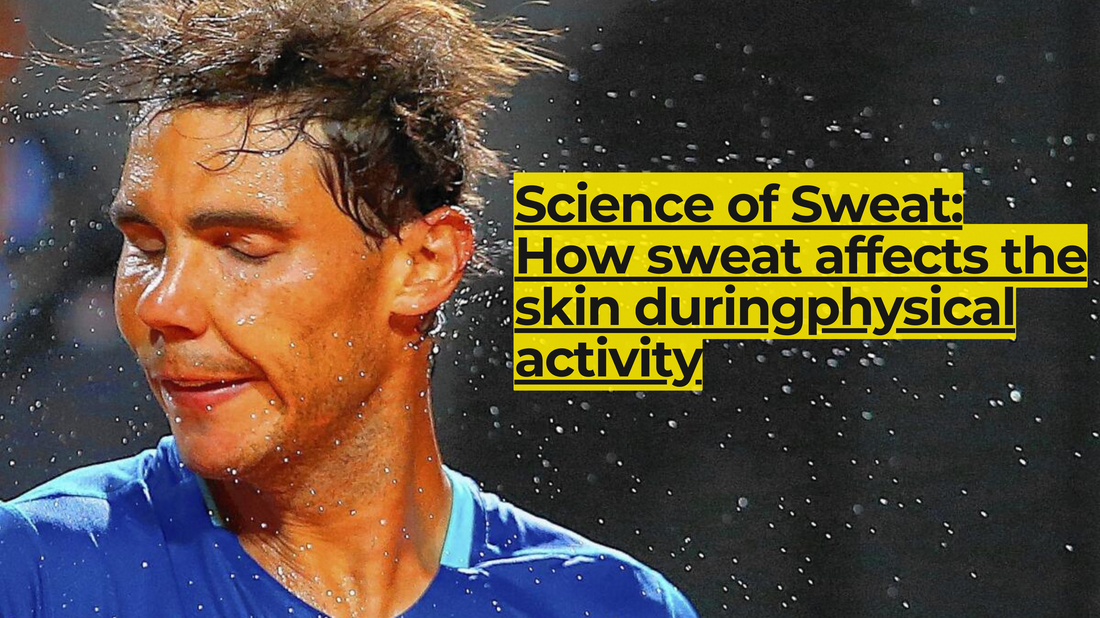Science of Sweat: How sweat affects the skin during physical activity
The Science of Sweat: Understanding its Impact on Skin
Sweating is a natural phenomenon experienced by almost all individuals. Though the levels and intensity of sweat may vary depending on whether you are an athlete, fitness enthusiast, or someone not involved in too much physical activity, understanding the science of sweat and its impact on skin is vital. Once we have a thorough understanding of the aforementioned, it is then important to know how we can take proper care of our skin and prevent it from getting damaged due to sweat.
Science of sweat: Understanding its impact on skin
Like discussed earlier, almost everyone tends to sweat. While some of us may be heavy sweaters, some others would experience just light perspiration. But have you ever wondered why we actually sweat? The answer is quite interesting. The main function of sweating is to control body temperature. As the water in the sweat evaporates, the surface of the skin cools. An additional function of sweat is to help with gripping, by slightly moistening the palms. In other words, sweat's main purpose is to help the body cool down. How it essentially works is that the sweat glands release sweat onto the skin, which then evaporates and helps reduce the body's internal temperature. These sweat glands are triggered by the nervous system automatically when your body temperature rises. Sweating also occurs, especially on your palms, when you are nervous.
So, the next question that pops up is: if sweating is healthy?
An exhaustive body of research has observed that sweating is a healthy way to release build-up and impurities and this is a proven fact. However, it is essential to note that sweating can also clog up your pores, causing breakouts and other skin issues on your face and throughout your body.
Impact of sweat on skin
Sweat can have some serious impact on the skin causing skin-related problems like acne, itchiness, and rashes, to name a few.
Acne breakouts: When you sweat, its droplets mix with bacteria and oils on your skin, thereby clogging your pores. If you have a sensitive skin that is vulnerable to acne, sweat can cause acne breakouts.
Itchiness: It is known that under certain circumstances, sweat can cause itching. For instance, when you sweat profusely, excessive sweat accumulates on the skin surface and if it stays for a long period there, miliaria can develop and eventually cause itching.
Rashes: Sweat can trigger the development of miliaria, commonly known as sweat rash. Though it is a harmless type of rash, it can cause itchiness. Some of the symptoms of sweat rash include small red spots in places where sweat collects, such as the armpits, back, under the breasts, chest, groin, elbow creases and back of the knees, and the waist.
Tips for post-exercise skincare
There are a range of products available in the market that provide relief to the skin that has soaked in sweat after an intense exercise or workout session. Whether you have hit the gym or played any sport that requires handling of sporting equipment, following are some of the tips that will help you enjoy yourself without worrying about sweat and its adverse impacts on the skin and performance.
Clean your face with a face wash: Washing your face properly with a face wash after completing your physical activity or exercise is necessary. Face wash helps to remove impurities and other infectious particles that would have settled on your face while you were involved in outdoor physical activity. While choosing a face wash, ensure that you opt for a charcoal face wash, which is arguably considered the best in the business.
Charcoal face wash assists in getting rid of excessive oils on the skin. It also cleanses bacteria, dirt, impurities, and other toxins, thus purifying the skin. Besides, face wash rich in Vitamin C and Vitamin E ensure enhanced and nourishing skin.
Apply a moisturiser: No skincare routine is complete without moisturiser. If you do not apply moisturiser after cleaning your face with a face wash, the skin may look dry and unhealthy. The moisturiser assists in restoring water and oil levels in the skin, thus regaining the hydration levels and making it look nice and healthy.
Use a skin recovery serum: Sweat can cause a range of skin issues including skin damage, redness and dehydration. To fight against these skin problems, use of skin recovery serum is advisable. Skin recovery serum contains antioxidants which combat against free radical damage, thus averting aging of skin and other related ailments.
Include hydrogel in your skincare routine: Due to their flexible and tunable properties, hydrogel dressings can obtain additional functional properties by loading cells, antibacterial, antiviral, and antifungal agents, growth factors, and biomolecules to speed up wound contraction and healing.
Don’t forget the talcum powder: Sweat is an inevitable part of any sport and to keep the sweat away or manage it effectively use of talcum powder is suggested. Talcum powder can absorb sweat and give your hands a better grip, especially when you are playing sports that involve handling of sporting equipment.
Keep hand grip or GripStrong cream handy: Hand grip or GripStrong cream is a grip enhancement product with an aggressive non-slip grip formulation. This cream is applied to the hands, enabling complete control to the players involved in sports that demand handling of sporting equipment. It gives the players superior grip and maximum control, allowing them to deliver their 100%, keeping the sweat at bay. This cream forms a dry barrier over the skin to prevent sweaty, oily perspiration.
Fight sweat with a hand gel: The best way to keep sweat away is washing your hands at regular intervals while playing the sport. If it is not possible, then ensure that you carry a pocket-sized hand gel. The gel will help you cleanse and dry your hands.








